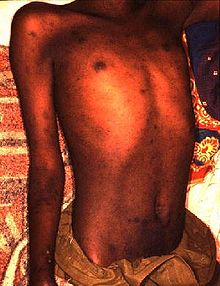
Back Tifus Afrikaans Tifus AN حمى نمشية Arabic التيفوس ARZ Tifus AST Tifus Azerbaijani تیفوس AZB Сабыртмалы тиф Bashkir Šiltėnė BAT-SMG Тиф Bulgarian
| Typhus | |
|---|---|
| Other names | Typhus fever |
 | |
| Rash caused by epidemic typhus | |
| Specialty | Infectious disease |
| Symptoms | Fever, headache, rash[1] |
| Complications | Meningoencephalitis |
| Usual onset | 1–2 weeks after exposure[2] |
| Causes | Bacterial infection spread by parasites[1] |
| Risk factors | Poor sanitation |
| Prevention | Avoiding exposure to organisms known to carry the disease |
| Treatment | Doxycycline[2] |
| Frequency | Rare[3] |
Typhus, also known as typhus fever, is a group of infectious diseases that include epidemic typhus, scrub typhus, and murine typhus.[1] Common symptoms include fever, headache, and a rash.[1] Typically these begin one to two weeks after exposure.[2]
The diseases are caused by specific types of bacterial infection.[1] Epidemic typhus is caused by Rickettsia prowazekii spread by body lice, scrub typhus is caused by Orientia tsutsugamushi spread by chiggers, and murine typhus is caused by Rickettsia typhi spread by fleas.[1]
Vaccines have been developed, but none are commercially available.[3][4][5] Prevention is achieved by reducing exposure to the organisms that spread the disease.[3][4][5] Treatment is with the antibiotic doxycycline.[2] Epidemic typhus generally occurs in outbreaks when poor sanitary conditions and crowding are present.[6] While once common, it is now rare.[3] Scrub typhus occurs in Southeast Asia, Japan, and northern Australia.[4] Murine typhus occurs in tropical and subtropical areas of the world.[5]
Typhus has been described since at least 1528.[7] The name comes from the Greek tûphos (τῦφος), meaning 'hazy' or 'smoky' and commonly used as a word for delusion, describing the state of mind of those infected.[7] While typhoid means 'typhus-like', typhus and typhoid fever are distinct diseases caused by different types of bacteria, the latter by specific strains of Salmonella typhi.[8] However, in some languages such as German, the term typhus does mean 'typhoid fever', and the here-described typhus is called by another name, such as the language's equivalent of 'lice fever'.
- ^ a b c d e f "Typhus Fevers". CDC.gov. Centers for Disease Control and Prevention. 7 March 2017. Archived from the original on 26 March 2017. Retrieved 26 March 2017.
- ^ a b c d "Information for Health Care Providers | Typhus Fevers". CDC.gov. Centers for Disease Control and Prevention. 7 March 2017. Archived from the original on 27 March 2017. Retrieved 26 March 2017.
- ^ a b c d "Epidemic Typhus | Typhus Fevers". CDC.gov. Centers for Disease Control and Prevention. 7 March 2017. Archived from the original on 26 March 2017. Retrieved 27 March 2017.
- ^ a b c "Scrub Typhus". CDC.gov. Centers for Disease Control and Prevention. 7 March 2017. Archived from the original on 26 March 2017. Retrieved 26 March 2017.
- ^ a b c "Murine Typhus". CDC.gov. Centers for Disease Control and Prevention. Archived from the original on 26 March 2017. Retrieved 26 March 2017.
- ^ "Typhus". WHO.int. World Health Organization. May 1997. Archived from the original on 27 March 2017.
- ^ a b Bennett JE, Dolin R, Blaser MJ (2014). Mandell, Douglas, and Bennett's Principles and Practice of Infectious Diseases E-Book. Elsevier Health Sciences. p. 2217. ISBN 9780323263733. Archived from the original on 10 September 2017.
- ^ Evans AS, Brachman PS (2013). Bacterial Infections of Humans: Epidemiology and Control. Springer. p. 839. ISBN 9781461553274. Archived from the original on 10 September 2017.